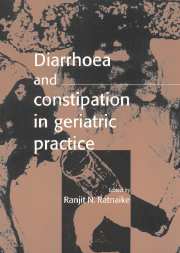Book contents
- Frontmatter
- Contents
- List of contributors
- Preface
- Acknowledgments
- Foreword by Gary R. Andrews
- I Defences of the aging gastrointestinal tract
- II Diarrhoea
- 3 Pathophysiology of diarrhoea
- 4 History and physical examination
- 5 The investigation of diarrhoea
- 6 Faecal incontinence
- 7 Drug-induced diarrhoea
- 8 Aetiology of infectious diarrhoea
- 9 Specific infectious conditions
- 10 An overview of management of infectious diarrhoea
- III Noninfectious clinical entities
- IV Constipation
- V Perspectives of altered bowel function
- Index
6 - Faecal incontinence
Published online by Cambridge University Press: 17 August 2009
- Frontmatter
- Contents
- List of contributors
- Preface
- Acknowledgments
- Foreword by Gary R. Andrews
- I Defences of the aging gastrointestinal tract
- II Diarrhoea
- 3 Pathophysiology of diarrhoea
- 4 History and physical examination
- 5 The investigation of diarrhoea
- 6 Faecal incontinence
- 7 Drug-induced diarrhoea
- 8 Aetiology of infectious diarrhoea
- 9 Specific infectious conditions
- 10 An overview of management of infectious diarrhoea
- III Noninfectious clinical entities
- IV Constipation
- V Perspectives of altered bowel function
- Index
Summary
Epidemiology
Faecal incontinence (FI) is a problem predominantly detected in the elderly and is particularly prevalent amongst institutionalized patients, unlike urinary incontinence, which occurs to a significant degree in all age groups. In nursing homes the prevalence is more than 20 per cent, usually in association with urinary incontinence, and is reported to range from 13 per cent to 47 per cent in hospitalized elderly patients. In residential homes in the United Kingdom (these homes provide a level of care that is approximately comparable to that offered in Australian hostels) the prevalence was 10.3 per cent. The prevalence of FI in a community setting was 10.9 per 1000 in males and 13.3 per 1000 in females over the age of 65 years.
Anorectal anatomy and physiology
The anal canal is surrounded by two concentric tubes of musculature, the internal and external sphincters (Figure 6.1). The internal sphincter is a thickened continuation of the rectal muscle wall, about 3 cm long and 4 mm deep, and is composed of smooth muscle. It is under autonomic control and accounts for 70 per cent of resting sphincter pressure.
The external sphincter, which constitutes the pelvic floor, is made up of striated muscle. The cranial part consists of the levator ani, the intermediate part is the puborectalis sling, and the caudal part is the external anal sphincter, which overlies the internal sphincter. Functionally, all of the components of the external sphincter act together.
- Type
- Chapter
- Information
- Diarrhoea and Constipation in Geriatric Practice , pp. 70 - 78Publisher: Cambridge University PressPrint publication year: 1999
- 2
- Cited by



